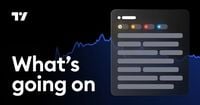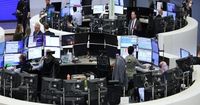Stocks across Asia and oil prices edged lower on Tuesday, August 19, 2025, as investors braced for a pivotal week packed with high-stakes central bank meetings and a flurry of diplomatic moves aimed at ending Russia’s protracted war in Ukraine. The mood in global markets was cautious, with traders weighing the potential impact of both monetary policy decisions and fresh signals of progress in peace negotiations between Kyiv and Moscow.
According to Reuters, Japan’s Nikkei share gauge set a new intraday record high at the opening bell, only to reverse course and finish down 0.5% by the end of the session. A sharp 5% drop in SoftBank Group shares, following the company’s announcement of a $2 billion investment in struggling U.S. chip giant Intel, weighed heavily on the index. Across the broader region, MSCI’s Asia-Pacific shares outside Japan slipped 0.2%, mirroring the cautious tone seen on Wall Street the previous day.
Meanwhile, European equity futures posted modest gains as diplomatic optimism swelled. Pan-region Euro Stoxx 50 futures climbed 0.3%, German DAX futures rose 0.2%, and FTSE contracts added 0.3%. The euro itself held steady at $1.1658, while the dollar index inched up to 98.171 after a 0.2% gain in the prior session, as reported by Reuters and other outlets. The U.S. dollar was little changed at 147.78 yen. U.S. crude oil prices dipped 0.2% to $63.29 a barrel, and spot gold ticked slightly higher to $3,334.9 per ounce.
But it wasn’t just the numbers that had traders glued to their screens. The diplomatic front delivered a jolt of hope, as Ukrainian President Volodymyr Zelenskiy said that security guarantees for Ukraine would likely be hammered out within 10 days, following talks with U.S. President Donald Trump and European leaders. The meeting, held in Washington, marked a sharp departure from previous, frostier encounters between Trump and Zelenskiy. This time, the atmosphere was warm and even lighthearted, with Trump complimenting Zelenskiy on his black suit—a subtle but telling contrast to their chilly February meeting, when Zelenskiy’s military garb drew criticism in the Oval Office.
“It was the best of our meetings,” Zelenskiy declared, as reported by Free Malaysia Today. Trump, in turn, assured the Ukrainian leader that the U.S. would help guarantee Ukraine’s security in any deal reached to end Russia’s aggression. The sense of optimism was palpable, and the enthusiasm appeared contagious. NATO Secretary General Mark Rutte, speaking to Fox News, described the gathering between Trump, Zelenskiy, and European and NATO partners as “very successful.” German Chancellor Friedrich Merz echoed the sentiment, noting that his expectations for the summit were “exceeded.” Even Russia struck a positive note, with Kirill Dmitriev, Moscow’s special envoy for investment and economic cooperation, calling August 18 “an important day of diplomacy.”
Still, the road to peace remains fraught with uncertainty. The recent Washington meetings followed a summit in Alaska between Trump and Russian President Vladimir Putin, which failed to yield a breakthrough on ending the three-and-a-half-year war. Yet Trump was quick to announce, in a social media post late Monday, that he had called Putin and begun arranging a direct meeting between the Russian leader and Zelenskiy, with plans for a trilateral summit among the three presidents to follow. According to multiple news outlets, this initiative has raised hopes that a diplomatic resolution, while not imminent, might finally be within reach.
“A dovish shift is being priced in, with further strength in equity markets—and weakness in the U.S. dollar—reliant on the Fed meeting these expectations,” wrote Kyle Rodda, an analyst at Capital.com, in a note to clients cited by Reuters. The focus now shifts to the U.S. Federal Reserve’s annual Jackson Hole symposium, scheduled for August 21-23, where Chair Jerome Powell is set to deliver a closely watched speech on the economic outlook and the central bank’s policy framework.
Money markets are already reflecting high expectations for monetary easing. According to CME FedWatch, there is an 83.6% to 85% chance of a quarter-point rate cut at the Fed’s next policy meeting on September 17, 2025. In the eurozone, rate expectations remain stable, with no change priced in for September, as reported by multiple sources. Investors are keenly awaiting Powell’s remarks for any hints on the Fed’s next moves, especially as the global economy continues to grapple with the aftershocks of pandemic-era disruptions and ongoing geopolitical tensions.
Adding to the week’s flurry of central bank activity, Fed governor Michelle Bowman—one of the two dissenting voices favoring a rate cut at the Fed’s last meeting—was scheduled to speak at the Wyoming Blockchain Symposium on August 19. Other key developments on investors’ radars included Home Depot’s Q2 earnings, U.S. housing starts and building permits for July, Canada’s July consumer price index, and debt sales of German 5-year notes and British 10-year gilts. The Riksbank’s monetary policy meeting in Sweden also featured on the global economic calendar.
As markets digest these overlapping currents of monetary policy and diplomacy, the stakes could hardly be higher. The Jackson Hole symposium, long regarded as a bellwether for central bank thinking, has the potential to trigger volatility across global assets. “The Jackson Hole Symposium looms as one potential source of volatility, and going into the event, the markets remain cautious,” noted Rodda. With both traders and policymakers walking a tightrope, any unexpected signal from Powell or his colleagues could send ripples through equities, currencies, and commodities alike.
Meanwhile, the diplomatic thaw between the U.S., Ukraine, and Russia is being watched with a mix of hope and skepticism. The war in Ukraine, now in its fourth year, has cast a long shadow over the region and rattled global energy markets. While the positive tone from recent meetings is encouraging, observers caution that translating goodwill into concrete agreements will require deft negotiation—and perhaps a bit of luck.
In the end, the coming days promise no shortage of drama for investors and diplomats alike. With central bankers poised to chart the course for global monetary policy and world leaders inching toward a possible end to one of Europe’s most stubborn conflicts, the world will be watching closely. For now, markets are holding their breath, waiting to see whether the week’s events will deliver the clarity—and the peace—that so many hope for.

